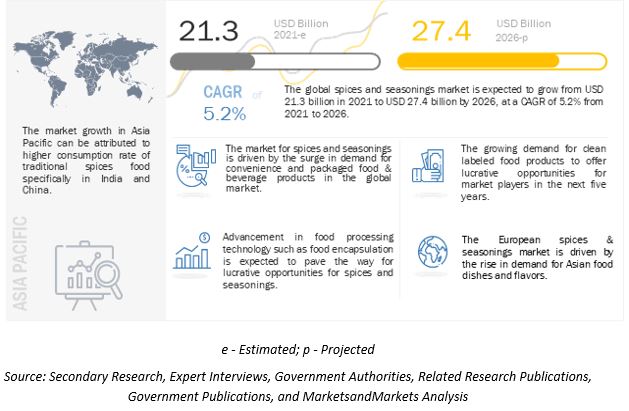The global spices and seasonings market is expected to grow from USD 21.3 billion in 2021 to USD 27.4 billion by 2026, at a CAGR of 5.2% from 2021 to 2026. The demand for spices and seasonings as key ingredients in various cuisines is rising globally. Factors such as the increasing demand for packaged or convenience food products and meat & poultry products, owing to changing consumer lifestyles, are expected to increase the demand for spices and seasonings globally. The demand for spices and seasonings is anticipated to increase in the Asia Pacific region owing to factors such as rising disposable income, rapidly growing fast food industry, and urbanization in countries such as China, India, and Japan. The rising consumer awareness about the medicinal benefits associated with the consumption of spices is also expected to increase the demand for spices and seasonings globally. However, increasing instances of unfair trade practices such as adulteration are expected to restrain market growth. Though the prices of spices and seasonings are highly volatile and vary across different regions, the market is expected to grow significantly.

Spices and Seasonings Market Drivers:
1. Growing Awareness of Health Benefits
- Spices like turmeric, ginger, and cinnamon are renowned for their anti-inflammatory and antioxidant properties.
- Rising consumer interest in functional foods has increased demand for health-boosting spices.
2. Increasing Popularity of Ethnic and Exotic Cuisines
- Globalization and cultural exchange have introduced new flavors and spice blends to diverse consumer groups.
- The expansion of international food chains and travel trends has boosted the demand for authentic seasonings.
3. Surge in Demand for Organic and Clean-Label Products
- Consumers are prioritizing organic, non-GMO and minimally processed spices.
- Clean-label movements emphasize transparency in ingredient sourcing and production processes.
4. Expansion of the Food Processing Industry
- The use of spices is increasing in processed foods, snacks, ready-to-eat meals, and beverages.
- Innovations in food manufacturing continue to drive demand for diverse seasoning blends.
5. E-Commerce and Digital Retail Growth
- Online grocery shopping and direct-to-consumer sales have made a wider variety of spices accessible.
- Artisanal and specialty spice brands are leveraging digital platforms to expand their reach.
Download PDF Brochure: https://www.marketsandmarkets.com/pdfdownloadNew.asp?id=739
Meat & Poultry products account for the most share in the global spices & seasonings market.
The meat & poultry products segment accounted for the largest value during the forecast period, probably because spices stimulate the appetite, add flavor, and act as natural preservatives for meat and poultry products. Different spices and seasonings, such as pepper, cinnamon, cardamom, cumin, turmeric, and capsicum, are applied to meatloaves, sausages, salamis, and other processed meat & poultry food products. Both fresh and frozen meats can be spiced and marinated before storage. All these factors have resulted in the high use of spices in the preparation of meat products. Hence, resulting in a high market share. Commercial meat processing plants use spice extracts in place of natural spices. Seasonings and spices used for sausage making are usually fresh, as most consumers prefer the taste of freshly made food that often comes from spices. Spices such as garlic, pepper, and chili play a crucial role in the antioxidants and natural preservatives in fermented meat products.
Organic spices are preferred as the demand for natural inputs increases.
Organic spices are wholesome, non-GMO, and free of insecticides and pesticides. Organics spices are artificially enhanced to be visually appealing. Since organic species are grown without any usage of harmful chemicals to maintain the plant’s phytonutrients properly, the original flavor of spices is preserved. Also, with changing trends in food and a growing interest in the beneficial natural properties of food, consumers take comfort in knowing that their food comes from farms that engage in natural farming practices. For this reason and more, earning the right to use an organic label adds value to brands because it indicates a high-quality product. In the developed regions, such as Europe, the popularity of organic spices is increasing as they are made of natural ingredients and are free from pesticides.
Top Spices and Seasonings Manufacturers
The key players in this market include MOGUNTIA FOOD GROUP AG (Germany), Associated British Food plc (UK), Olam International (Singapore), McCormick & Company (US), and Ajinomoto Co., Inc. (Japan), Paras Spices Private Limited (India), Worlée Gruppe (Germany), Döhler Group (Germany), Friedrich Ingredients (Germany), Kerry Group Plc (Ireland), ARIAKE JAPAN Co., Ltd. (Japan), Pacific Spice Company (US), Sensient Technologies (US), SHS Group (Ireland), and VKL Seasonings Pvt Ltd. (India).